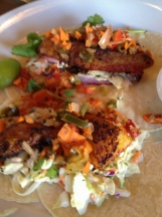Reggie Graves, one of our best friends from our days in Louisiana, recently paid us a visit. Reggie is well-known for his championship chili – I have written about it in the past – but he is an excellent cook besides that. Whenever we have a chance to visit with Reggie, you can be sure that there will be good food and lots of talk about food.
We were definitely not disappointed on this visit. Reggie brought us a huge bag of shelled pecans and the promise to make his favorite microwave pralines.
During one evening of reminiscing about old times, we talked about a famous praline shop in the New Orleans French Quarter on Decatur between Jackson Square and the French Market. I am not sure that the shop still exists, especially after the devastation of Hurricane Katrina. The memory lingers on, beginning with the fragrance of caramel and roasted pecans drifting out onto the street for blocks around the shop. The accompanying visual is of a huge woman hovered over an equally huge copper pan filled with bubbling caramel and pecans. The woman would stir and stir the mixture until it was just right, and then she would ladle dollops of the blazing hot mixture onto a cool marble table. When the pralines had cooled, she would wrap them in squares of waxed paper, ready for sale to the many tourists who had lined up to watch her. Of course, the taste memory is biting into a golden brown praline filled with pecans and cooked so perfectly that the caramel was soft and chewy without any sugary texture.
Making pralines at home can be a challenge. First, you probably don’t have a big copper vat. Then there is the matter of getting the caramel cooked just right so that it is creamy without a trace of sugar crystals. That means that many home cooks – this one included – prefer to buy their pralines from a good candy store.
Those challenges are what makes this recipe so great. You can make perfect pralines in just a few minutes using your microwave. The biggest problem is to make certain that the time of cooking is tied to the wattage of your microwave oven. This recipe is designed for a 1000 watt appliance. To make it a general recipe, I tried to see if there are tables or graphs to suggest how you should adjust cooking time according to oven wattage. Indeed, there are lots of tables available, but I found most of them confusing and difficult to use. Instead, I developed a simple formula which you can use as a beginning guideline. You will probably need to experiment to find the ideal time for your oven, but a beginning point is to divide 1000 by the wattage of your oven and multiply the cooking time in this recipe (12.5 minutes) to find the approximate correct cooking time for your oven.
The other essential secret is to use a large enough (eight cups at least) microwave-proof bowl to boil the praline mixture.
With that, here is the recipe:
RECIPE
Ingredients
- 1 pound light brown sugar
- 1 cup heavy cream
- 2 cups shelled pecan halves
- 2 tablespoons butter
- enough softened butter to grease a large baking sheet
Method
-
In the large microwave-proof bowl or pitcher, combine the brown sugar and cream.
- Using a 1000 watt microwave oven with turntable, cook the brown sugar and cream mixture on High for exactly 12.5 minutes
- Using a hot pad, transfer the bowl with the cooked mixture to a heat-proof surface.
- Stir in the pecan halves and the butter,
- Working quickly, when the pecans are completely coated and the butter is melted and incorporated, form the pralines
- With a soup spoon or tablespoon, ladle spoonfuls of the mixture onto the buttered baking sheet.
- Cool enough before eating so that you don’t burn your tongue, but pralines are delicious warm or cold.
- If you get tired of eating just the pralines, try crushing them before sprinkling them over dishes of vanilla ice cream



























